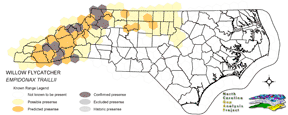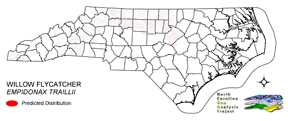
| Taxa: |
| Order: |
| Family: |
| Aves |
| Passeriformes |
| Tyrannidae |
| NatureServe Global Rank: |
| NatureServe State (NC) Rank: |
| G5 |
| S3B,SZN |
| Federal Status: |
| NC State Status: |
| --- |
| W2 |


| Land Unit |
| US Fish & Wildlife Service |
| US Forest Service |
| US National Park Service |
| US Department of Defense |
| NC State Parks |
| NC University System |
| NC Wildlife Res. Com. |
| NC Forest Service |
| NC Div. of Coastal Mgmt. |
| Local Governments |
| Non-Governmental Org. |
| Other Public Lands |
| Private Lands |
| GAP Status 1-2 |
| All Protected Lands |
| Statewide |
| Hectares |
| 7.92 |
| 1,002.69 |
| 1,228.59 |
| 153.81 |
| 136.35 |
| 21.42 |
| 631.71 |
| 11.43 |
| 0.00 |
| 179.37 |
| 23.67 |
| 4.77 |
| 96,373.53 |
| 702.90 |
| 2,211.48 |
| 99,775.26 |
| Acres |
| 19.57 |
| 2,477.70 |
| 3,035.91 |
| 380.07 |
| 336.93 |
| 52.93 |
| 1,560.99 |
| 28.24 |
| 0.00 |
| 443.23 |
| 58.49 |
| 11.79 |
| 238,144.13 |
| 1,736.90 |
| 5,464.69 |
| 246,549.99 |
| % of Dist. on |
| Prot. Lands |
| 0.4 % |
| 45.3 % |
| 1.8 % |
| 7.0 % |
| 6.2 % |
| 1.0 % |
| 28.6 % |
| 0.5 % |
| 0.0 % |
| 1.0 % |
| 1.0 % |
| 0.2 % |
| 0.0 % |
| 31.8 % |
| ----- |
| ----- |
| % of Dist. on |
| All Lands |
| < 0.1 % |
| 1.0 % |
| 1.2 % |
| 0.2 % |
| 0.1 % |
| < 0.1 % |
| 0.6 % |
| < 0.1 % |
| 0.0 % |
| 0.2 % |
| < 0.1 % |
| < 0.1 % |
| 96.6 % |
| 0.7 % |
| ----- |
| ----- |
|
Found in the mountains uncommon to locally fairly common (but more widespread than Empidonax alnorum) and rarely in the piedmont (Hamel 1992, Simpson 1992). Favors areas of deciduous thickets and shrubs, or woodland edges (Hamel 1992, Kaufman 1996, Simpson 1992). Rarely far from water, i.e. swamps, streams, marshes, or bogs (Hamel 1992, Kaufman 1996). Hamel (1992) describes the Willow Flycatcher as 'foraging entirely within 20 feet of the ground.' Frequently breeds in wet thickets of deciduous trees/saplings, often willows or alders (Hamel 1992, Harrison 1975, Kaufman 1996, Simpson 1992). Nest is from 2 to 15 feet above the ground, on a horizontal branch or in the crotch of a vertical or diagonal limb (Kaufman 1996, Potter et al 1980). The nest consists of grass, strips of bark and plant fibers, lined with fine grass and other soft materials (Harrison 1975, Kaufman 1996). Willow Flycatchers forage on flying insects from tall shrubs and sapling thickets, catching them in flight or gleaning from foliage (Hamel 1992, Kaufman 1996). NATURE SERVE GLOBAL HABITAT COMMENTS: Thickets, scrubby and brushy areas, open second growth, swamps, and open woodland (AOU 1983). Common in mountain meadows and along streams; also in dry brushy upland pastures (especially hawthorn) and orchards (NGS 1983). Nests primarily in swampy thickets, especially of willow and buttonbush (AOU 1983), also dogwood, elderberry, hawthorn, rose, tamarisk, and others; in fork or on horizontal limb of shrub, usually 1-3 m above ground (see Harris 1991). See Sedgwick and Knopf (1992) for information on nest sites and song perches in northcentral Colorado. |
| Code | Name | Description | NC Natural Heritage Program Equivalent |
| 239 | Piedmont/Mountain Emergent Vegetation | Emergent vegetation of all wetland hydrologies. Sites would commonly support species such as tussock sedge, rushs, and cattail alliances. | Rocky Bar and Shore (in part) |
| 267 | Riverbank Shrublands | Riverside shrubs with temporarily flooded hydrologies. Found in the both the Mountains and Piedmont. Containing dominants such as smooth alder and a Carolina or black willows. | Sand and Mud Bar |
| 269 | Floodplain Wet Shrublands | Saturated shrublands of the Piedmont, includes buttonbush, swamp-loosestrife, decodon and alders. | Piedmont/mountain Semipermanent Impoundment |
| 230 | Piedmont Mesic Forest | American Beech - Red Oak - White Oak Forests. | Mesic Mixed Hardwood |
| 384 | Piedmont/Mountain Mixed Bottomland Hardwood Forests | Includes temporarily to seasonally forests dominated by hardwood species. Hardwoods include sweetgum, red maple, sycamore which co-occur in a mosaic of bottomland and levee positions. Includes alluvial hardwood forests in the mountains. Hemlock and white pine may occur as inclusions, but are generally mapped separately. | Piedmont/Mountain Alluvial Forest, Piedmont/Mountain Levee Forest |
| 383 | Piedmont Mixed Successional Forest | Generally loblolly mixed with successional hardwoods. Sweetgum, tulip poplar and red maple are common co-dominants in these successional forests. | No equivalent |
| 51 | Deciduous Cultivated Plantation | Planted deciduous trees. Includes sweetgum and sycamore plantations. | No equivalent |
| 36 | Successional Deciduous Forests | Regenerating deciduous trees with a shrub stature. Commonly dominated by sweetgum, tulip poplars and maples. | No equivalent |
| 180 | Agricultural Crop Fields | Farm fields used for row crops. | No equivalent |
| 205 | Agricultural Pasture/Hay and Natural Herbaceous | Farm fields used for pasture grass or hay production, as well as old fields dominated by native and exotic grasses. | No equivalent |
| 202 | Residential Urban | Includes vegetation interspersed in residential areas. Includes lawns, mixed species woodlots, and horticultural shrubs. Vegetation accounts for between 20 - 70% of the cover. | No equivalent |
| 517 | Hemlock Floodplain Forest | Alluvial forest with hemlock and/or white pine in mountains and western piedmont. Hydrology is generally temporarily to seasonally flooded. | Canada Hemlock Forest |
| 522 | Northern Hardwoods | High Elevation forests including yellow birch, American beech, and yellow buckeye. Includes forests with Hemlock and Yellow Birch. | Northern Hardwoods Forest, Boulderfield Forest |
| 525 | Appalachian Oak Forest | A variety of oak forest types including Black, White, Scarlet Oaks in dry to mesic situations. Includes forests historically co-dominated by American Chestnut. | High Elevation Red Oak Forest, Montane White Oak Forest |
| 526 | Appalachian Cove Forest | Mixed Mesophytic forests of the mountains. Includes tuliptree, basswood, yellow buckeye and surgar maple. This class is mapped to include cove forests dominated or co-dominated by hemlock. | Rich Cove Forest, Acidic Cove Forest |
| 527 | Appalachian Hemlock | Upland hemlock forests of the moutains region. Vary from side slopes to steep slope positions. | Canada Hemlock Forest |
| 533 | Appalachian Swamp Forest | Evergreen and deciduous forests with saturated hydrologies. This class may contain a variety of trees species, including hemlock - red maple, pitch pine, and white pine forests. | Swamp Forest-Bog Complex, Southern Appalachian Bog, Southern Appalachian Fen |
| 534 | Appalachian Wet Shrubland/ Herbaceous | Saturated shrubs and herbaceous vegetation. Often mapped as an inclusion in Appalachian Swamp Forest. | Southern Appalachian Bog, Southern Appalachian Fen |
|
Winkler, K. 1994. Divergence in the mitochondrial DNA of EMPIDONAX TRAILLII and E. ALNORUM, with notes on hybridization. Auk 111:710-713.
U.S. Fish and Wildlife Service (USFWS). 1995. Final rule determining endangered status for the southwestern willow flycatcher. Federal Register 60(38):10694-10715. Bent, A.C. 1942. Life histories of North American flycatchers, larks, swallows, and their allies. U.S. National Museum Bulletin 179. Washington, DC. McCabe, R. A. 1991. The little green bird:ecology of the willow flycatcher. Rusty Rock Press, Madison, Wisconsin. xv + 171 pp. Ehrlich, P.R., D.S. Dobkin, and D. Wheye. 1992. Birds in jeopardy:the imperiled and extinct birds of the United States and Canada, including Hawaii and Puerto Rico. Stanford University Press, Stanford, California. 259 pp. Hamel, P. B. 1992. The land manager's guide to the birds of the south. The Nature Conservancy, Chapel Hill, North Carolina. 367 pp + several appendices. Simpson MB Jr. 1992. Birds of the Blue Ridge Mountains. Chapel Hill and London: University of North Carolina Press. Sedgwick, J. A., and F. L. Knopf. 1992. Describing willow flycatcher habitats:scale perspectives and gender differences. Condor 94:720-733. Prescott, D. R. C., and A. L. A. Middleton. 1988. Feeding-time minimization and the territorial behavior of the willow flycatcher (EMPIDONAX TRAILLII). Auk 105:17-28. Sedgwick, J. A., and F. L. Knopf. 1988. A high incidence of brown-headed cowbird parasitism of willow flycatchers. Condor 90:253-256. Kaufman K. 1996. Lives of North American Birds. Boston, New York: Houghton Mifflin Company. Phillips, A. R. 1948. Geographic variation in EMPIDONAX TRAILLII. Auk 65:507-514. Phillips, A., J. Marshall, and G. Monson. 1964. The birds of Arizona. The University of Arizona Press, Tucson. Harrison, H.H. 1975. A field guide to bird's nests in the U.S. east of the Mississippi River. Houghton Mifflin Company, Boston, Massachusetts. 257 p. Harrison, C. 1978. A field guide to the nests, eggs and nestlings of North American birds. Collins, Cleveland, Ohio. Harrison, H.H. 1979. A field guide to western birds' nests. Houghton Mifflin Company, Boston. 279 pp. Terres, J.K. 1980. The Audubon Society encyclopedia of North American birds. Alfred A. Knopf, New York. American Ornithologists' Union (AOU), Committee on Classification and Nomenclature. 1983. Check-list of North American Birds. Sixth Edition. American Ornithologists' Union, Allen Press, Inc., Lawrence, Kansas. National Geographic Society (NGS). 1983. Field guide to the birds of North America. National Geographic Society, Washington, D.C. Taylor, D. M., and C. D. Littlefield. 1986. Willow flycatcher and yellow warbler response to cattle grazing. American Birds 40:1169-1173. Biosystems Analysis, Inc. 1989. Endangered Species Alert Program Manual:Species Accounts and Procedures. Southern California Edison Environmental Affairs Division. Unitt, P. 1987. EMPIDONAX TRAILLII EXTIMUS:an endangered subspecies. Western Birds 18:137-162. Stiles, F.G., and A.F. Skutch. 1989. A guide to the birds of Costa Rica. Comstock Publ. Associates, Cornell University Press, Ithaca, New York. 511 pp. Harris, J. H. 1991. Effects of brood parasitism by brown-headed cowbirds on willow flycatcher nesting success along the Kern River, California. Western Birds 22:13-26. Droege, S., and J.R. Sauer. 1990. North American Breeding Bird Survey, annual summary, 1989. U.S. Fish and Wildlife Service, Biological Report 90(8). 22 pp. Kaufman, K. 1990. A field guide to advanced birding. Houghton Mifflin Co., Boston. xiv + 299 pp. Brown, B. T. 1988. Breeding ecology of a willow flycatcher population in Grand Canyon, Arizona. Western Birds 19:25-33. |
For more information please contact them at:
NC-GAP Analysis Project
Dept. of Zoology, NCSU
Campus Box 7617
Raleigh, NC 27695-7617
(919) 513-2853
www.basic.ncsu.edu/ncgap